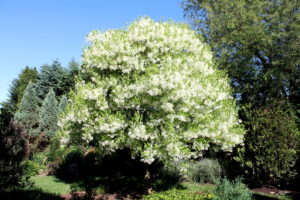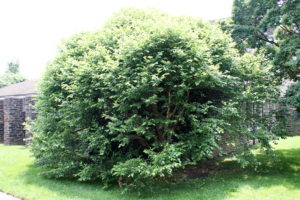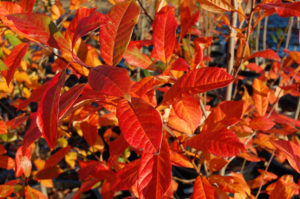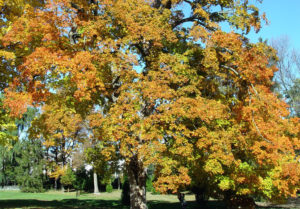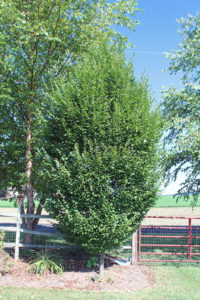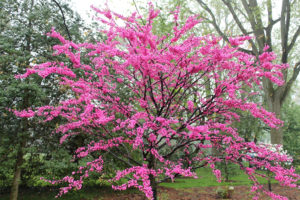Top 10 Native Trees for Home Landscapes
A lot of gardeners are trying to lean native in the landscape these days.
Trees are one of the easiest ways to do that because, fortunately, many native Pennsylvania and U.S. tree species are as functional survival-wise and wildlife-friendly-wise as they are beautiful and “well behaved.”
If you’re planning to add a tree or three to the yard, here are my top 10 favorite native trees.
(Chionanthus virginicus)
The unusual late-spring, shaggy white flowers of American fringe tree make this small native tree a prime candidate for the question, “What tree is that?” when people see it in bloom.
Nicknamed “old man’s beard,” the tree can be pruned to a single trunk or left to grow as a more irregular multi-stemmed tree.
Grows slowly to 15 to 18 feet tall and wide in full sun or as an under-story tree partly shaded by taller surrounding trees. Leaves turn yellow in fall.
(Betula nigra)
This fast-grower is typically found growing along river banks or similar damp areas in nature, so it’s a good choice for damp areas in the yard (although it’ll also tolerate drier soil).
River birch is best loved for its cinnamon-colored peeling bark and the arching habit of its multiple stems (three or four trunks are ideal).
Grows 35 to 40 feet tall, 20 to 25 feet around in full sun or part shade. Leaves turn yellow in fall.
(Nyssa sylvatica ‘Wildfire’)
The straight species of blackgum (also called “tupelo”) is especially spectacular in its flaming scarlet fall foliage, but the variety ‘Wildfire’ adds the feature of red new foliage in spring.
Birds love the small black fruits. Makes a nice back-yard shade tree.
Grows 50 to 60 feet tall and 20 to 25 feet wide in full sun.
(Cornus florida)
Arguably our most beloved flowering tree, American dogwoods are covered in showy white or pink flowers in late April, followed by burgundy fall foliage, and bright red oval fall fruits that birds relish.
American dogwoods are often troubled by borers and powdery mildew and anthracnose diseases, but if given rich, loose, acidic soil and an occasional deep soaking in drought weather, they’ll fight off trouble.
Grows about 18 feet tall and wide, ideally as an under-story tree or in a site that gets morning sun and afternoon shade.
(Magnolia virginiana)
Here’s an excellent choice as a patio tree – a small and slow-growing native magnolia that has dark-green glossy leaves and large, showy white flowers from May into early summer.
The flowers are mildly fragrant, and the leaves are evergreen in many (if not most) winters.
Grows 15 to 20 feet tall and slightly less in width, in full sun or part shade and preferably in acidic soil. Tolerates damp soil.
(Amelanchier x grandiflora)
Also called “juneberry” because of its small blueberry-like fruits in June, serviceberry is a dogwood-sized native tree that gets white flowers early in spring, then the June berries, then gorgeous orange-red fall foliage.
The fruits are edible (superb in pies), but you’ll have to beat the birds to the punch. Can be pruned to a single trunk or left to grow as a multi-stemmed small tree.
Grows 15 to 20 feet tall and wide in full sun or as an under-story tree in part shade.
(Acer rubrum)
Red maple is a moderately fast-growing Pennsylvania-native shade tree best known for its brilliant red (sometimes red/gold) fall foliage.
The leaves are wide and three-lobed with pointed tips, emerging red-tinged in spring before turning green for the summer. Varieties of it, such as October Glory, Red Sunset and Redpointe, make some of our showiest back-yard shade-tree options.
Most varieties grow 40 to 50 feet tall and 30 to 40 feet wide in full sun. Red maple tolerates damp or dry soil.
(Quercus rubra or Quercus alba)
Oaks are some of the most wildlife-beneficial choices of any native species, and these two are particularly good ones for landscape shade trees.
Northern red oak is a fairly fast-growing tree with a straight trunk, strong branching, and dark-red fall foliage. It typically grows 50 to 70 feet tall and wide.
White oak is also big, strong-limbed, majestic, distinctive for its light-gray bark color (lighter than other oaks), and like red oaks, a heavy acorn producer with dark-red fall foliage. It grows slightly bigger than red oak.
(Carpinus caroliniana)
American hornbeam is a mid-sized native shade tree with orange-red fall foliage and a smooth, gray trunk that resembles the shape of leg muscles (earning it the nickname “musclewood”).
It’s a slow-growing tree and a favorite nesting tree of hummingbirds. Wildlife enjoy the fall-maturing winged nutlets.
Grows 25 to 30 feet tall and 20 to 25 feet wide in full sun. ‘Fastigiata’ is a somewhat narrower form of the species.
(Cercis canadensis)
One of the first species to light up a Pennsylvania woodland in spring, redbud is a wide, vase-shaped tree best known for its magenta to pinkish-lavender flowers that appear before the leaves emerge in March to early April.
The leaves are heart-shaped and turn yellow in fall. Some varieties have dark or golden summer leaves.
Grows 18 to 20 feet tall and 25 to 28 feet wide, ideally in rich, loose, well drained soil and out of direct afternoon sun. In nature, it’s an under-story tree – not a front-yard specimen in full sun and clay soil.
The right way to plant a tree
Planting a tree isn’t as easy as digging a hole and dumping your new tree out of the pot and into the ground.
The soil should first be loosened in a wide area, the roots of the tree should be frayed out before planting, and there’s a critical juncture to locate when gauging how deep to plant.
The more you do right at planting time, the better the odds the new tree will survive and flourish.
Read George’s PennLive nine-step instructions on how to plant a tree
Read George’s article on “So you think you know how to plant a tree?”








